Weirdest Artworks – Bizarre Art That Messes With Your Mind
Weird is not a term often used freely in art criticism, yet some artworks from art history and the Contemporary historical record may make you reassess your version of “weird art”. The phenomenon of the weird can also be compared to the phenomenon of the uncanny and unique contrasts and features in artwork that just seem a little off. In this article, we will explore some of the strangest artworks of all time that will certainly leave you with a quizzical brow.
Contents
- 1 Notions of the “Weird” in Art History
- 2 The Top 15 Weirdest Artworks of All Time
- 2.1 The Melun Diptych (1452) by Jean Fouquet
- 2.2 Hell (1485) by Hans Memling
- 2.3 The Garden of Earthly Delights (c. 1490 – 1500) by Hieronymus Bosch
- 2.4 Gabrielle d’Estrées and One of Her Sisters (c. 1594) by Fontainebleau School
- 2.5 Magdalena Ventura with Her Husband and Son (1631) by Jusepe de Ribera
- 2.6 The Overturned Bouquet (1660 – 1679) by Abraham Mignon
- 2.7 Saturn Devouring His Son (1821 – 1823) by Francisco de Goya
- 2.8 Lobster Telephone (1936) by Salvador Dalí and Edward James
- 2.9 The Family (1918) by Egon Schiele
- 2.10 Monogram (1955 – 1959) by Robert Rauschenberg
- 2.11 Angry Dog (1938 – 1943) by Edvard Munch
- 2.12 The Physical Impossibility of Death in the Mind of Someone Living (1991) by Damien Hirst
- 2.13 Vanitas: Flesh Dress for an Albino Anorectic (1987) by Jana Štěrbáková
- 2.14 Body Worlds (Est. 1995) by Dr. Gunther von Hagens
- 2.15 Untitled (2008) by Roger Hiorns
- 3 Frequently Asked Questions
Notions of the “Weird” in Art History
When it comes to labeling art as “weird”, one would be careful not to dismiss the significance of including the “weird” or “uncanny” in the field of important art in art history. Weird artworks generally tend to feature unlikely compositions or pairings of subjects that either make you cringe or wonder how the artist even conceived of such a visual. Regardless of the uncanny phenomenon of weird art and what is classified as such, there are a few artworks that also superimpose certain aspects of life or content that are not often seen in the media, which adds to the perceived weirdness of an artwork.
Other interpretations of “the weird” in the arts refer to Surrealist artworks, which often deal with abstract subjects and equally mind-altering imagery that may confuse or startle many. Surrealist artworks generally branch out beyond the realm of Realism artworks.
Some of the strangest artworks in art history often challenge the perception of reality by superimposing the uncanny, the unseen, and the often, repressed visual narratives of life. It is also useful to remember that the term “weird” is also subjective and therefore to examine strange artwork through an art historical lens is to note that such artwork was commonly associated with controversy, shock-value media coverage, and publicity that spread outside of the fine arts sector. Below, we have compiled a list of famous weird art pieces that will shed some light into the different ways that weird art pieces take shape as well as the bizarre lens of viewing reality that many artists seem to share.
The Top 15 Weirdest Artworks of All Time
Ever wondered what the top 15 weirdest artworks in art history were? Wonder no more! Below, we will explore some of the most bizarre artworks that have captured the attention of more than just local art critics. These strange artworks will have you re-examining your beliefs to the extent that you can push the definition of art.

The Melun Diptych (1452) by Jean Fouquet
| Artist | Jean Fouquet (c. 1420 – 1481) |
| Date | 1452 |
| Medium | Oil on panel |
| Dimensions (cm) | 93 x 85 (each) |
| Where It Is Housed | Royal Museum of Fine Arts, Antwerp, Belgium |
The Melun Diptych was created in the mid-15th century by French court artist Jean Fouquet and portrays a classic religious scene featuring the figure Mary with the baby Jesus surrounded by angels. It is not the scene that is the weird part of the painting, rather, it is the aesthetic quality, color palette, and mechanical nature of the reverent subjects that make looking at this painting bizarre. Fouquet was commissioned to create the diptych by the treasurer of King Charles VII, Etienne Chevalier. The painting was also considered to be controversial for its time with Fouquet using the king’s mistress as the model for Mary.
The king’s mistress, Agnes Sorel, was a beauty of her time and was so admired that the king granted her an official place next to him as his mistress, which was never done before in the 15th century.
Hell (1485) by Hans Memling
| Artist | Hans Memling (1430 – 1494) |
| Date | 1485 |
| Medium | Oil on wood |
| Dimensions (cm) | 22 x 14 |
| Where It Is Housed | Musée des Beaux-Arts de Strasbourg, Strasbourg, France |
Hell is among the weirdest art pieces created by Hans Memling in 1485. The painting is considered weird for its main subject, which appears to be a creature with two faces, one being the head of a hound and the other, a strange bewildered-looking man. The creature represents the devil who also appears androgynous. An interesting aspect of the painting is that it is part of a triptych, which is also reversible and was created to showcase the contrast between good and evil. It is believed that the panel was created for meditation purposes. While it is unclear as to Memling’s original intention for the work or inspiration for the androgynous-looking devil, the painting’s fever-dream quality makes it one of the weirdest paintings of the 15th century.
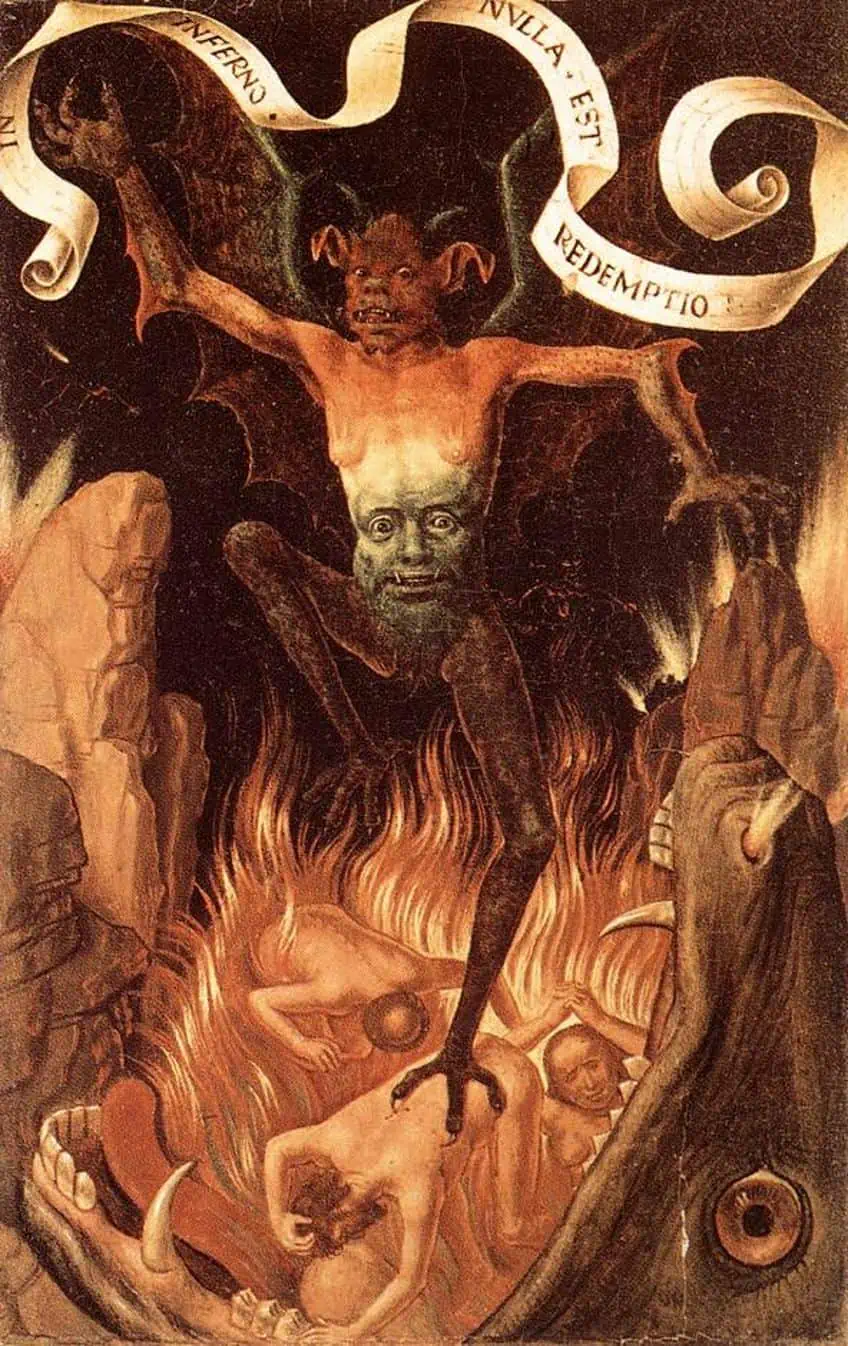
The Garden of Earthly Delights (c. 1490 – 1500) by Hieronymus Bosch
| Artist | Hieronymus Bosch (Jheronimus van Aken; 1450 – 1516) |
| Date | c. 1490 – 1500 |
| Medium | Oil on oak panels |
| Dimensions (cm) | 220 x 389 |
| Where It Is Housed | Museo del Prado, Madrid, Spain |
This famous Northern Renaissance oil triptych is considered to be one of the weirdest paintings in art history for its unique composition that features almost 110 figures in the painting. The strange and stunning triptych was created by Hieronymus Bosch who was a pioneering artist of Early Netherlandish painting. His representation of the biblical themes of creation, the temptation of human and earthly pleasure, hell, and sin are what make the artwork profound yet its complex imagery and strange-looking figures are what make it stand out as a “weird” painting.
Perhaps the weirdest scene from the triptych is the panel that illustrates the realm of hell and features a rumored self-portrait of Bosch with a sinister and playful smirk.
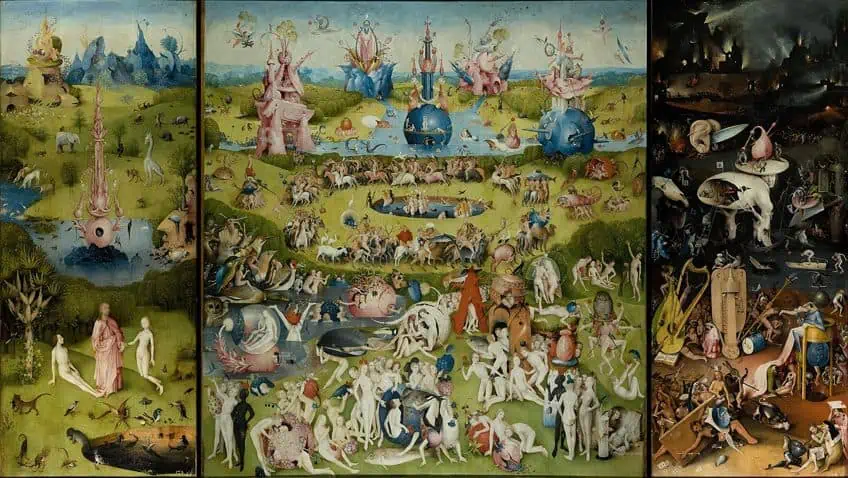
Gabrielle d’Estrées and One of Her Sisters (c. 1594) by Fontainebleau School
| Artist | The Second Fontainebleau School; an Unknown artist |
| Date | c. 1594 |
| Medium | Oil on wood |
| Dimensions (cm) | 96 x 125 |
| Where It Is Housed | Musée du Louvre, Paris, France |
At first glance, this painting is easily one of the best weird art pieces you might see from the 16th century that appears deceivingly homoerotic. The strange painting was created by an anonymous artist from the second Fontainebleau school and portrays the image of the Duchess de Villars’ pinching the nipple of her sister. As one inspects the finer details in the painting, the composition only gets stranger. Another weird aspect of the image is that the scene is presented as if it is occurring on a stage and the viewer, therefore, participates in this bizarre scene. The true meaning of the painting is that Gabrielle, the woman on the left, was King Henry IV’s mistress and was probably pregnant with the king’s illegitimate son. The act of pinching the other woman’s nipple was, in fact, a symbol of fertility, further emphasized by the mysterious figure in the background sewing clothes for a baby.

Magdalena Ventura with Her Husband and Son (1631) by Jusepe de Ribera
| Artist | Jusepe de Ribera (1591 – 1652) |
| Date | 1631 |
| Medium | Oil on canvas |
| Dimensions (cm) | 212 x 144 |
| Where It Is Housed | Museo Nacional del Prado, Madrid, Spain |
This famous oil painting has been categorized as one of the most bizarre artworks due to the unusual subject in the painting, which features a woman breastfeeding a newborn baby. The striking aspect of the painting is that the woman in the forefront does not appear to resemble a 17th-century woman and was identified as a woman named Magdalena Ventura. It is believed that the woman was the primary breadwinner in her family, as highlighted by her beard and traditionally masculine appearance. Her husband also seems to fall submissively into the background.
This unusual painting was created by Jusepe de Ribera, who was one of the major Spanish Baroque artists of the 17th century.
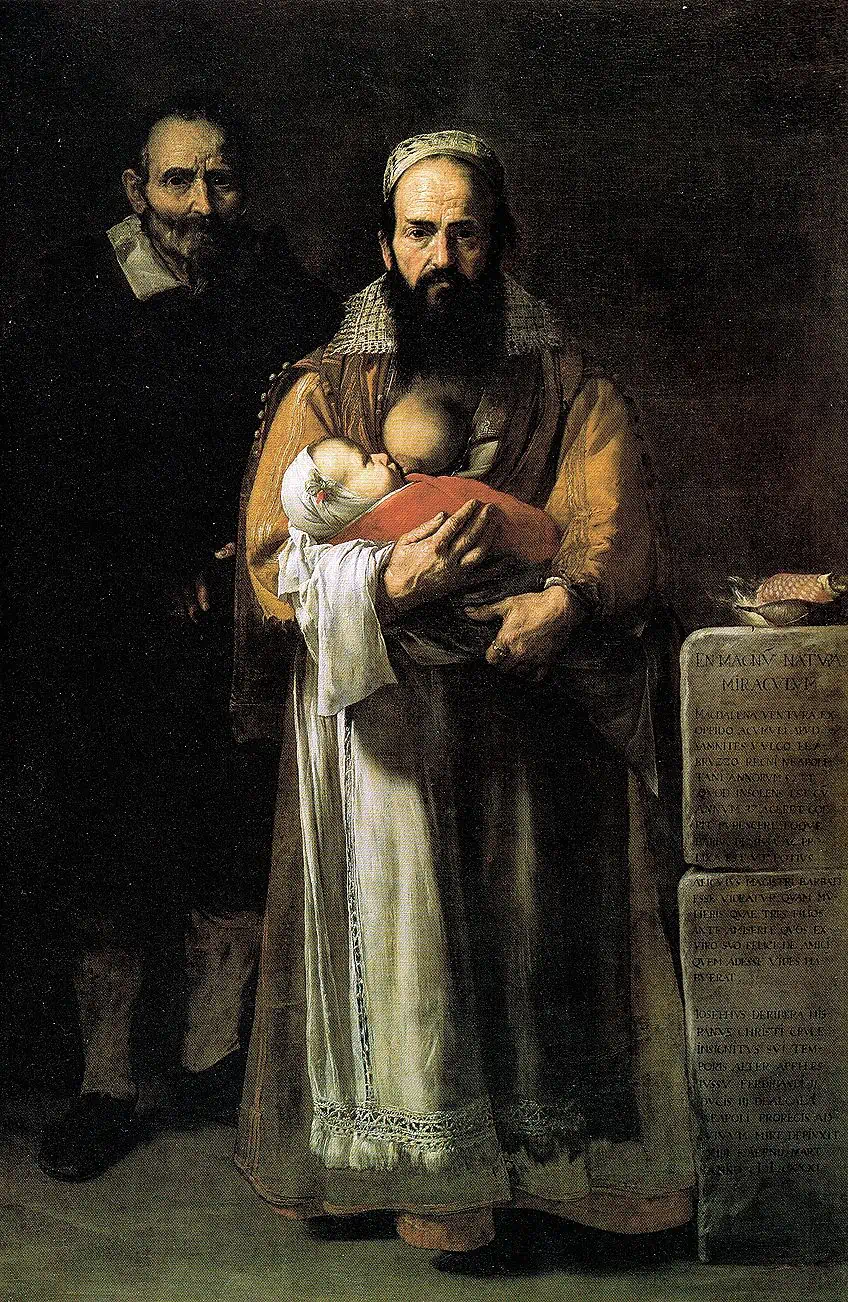
The Overturned Bouquet (1660 – 1679) by Abraham Mignon
| Artist | Abraham Mignon (1640 – 1679) |
| Date | 1660 – 1679 |
| Medium | Oil on canvas |
| Dimensions (cm) | 89.5 x 71.5 |
| Where It Is Housed | The Rijksmuseum, Amsterdam, Netherlands |
The Overturned Bouquet is a famous still-life painting by German Baroque artist Abraham Mignon whose eye for detail and Realism was greatly admired. Despite his talent for inanimate objects, it seems he may have missed the mark on the odd-looking cat, which dons an uncanny resemblance to both a startled cat and a monkey. It is perhaps the weirdest rendered cat one might encounter in an attempt at a Realist-Baroque painting and certainly stands out among the beautifully executed flowers.

Saturn Devouring His Son (1821 – 1823) by Francisco de Goya
| Artist | Francisco José de Goya y Lucientes (1746 – 1828) |
| Date | 1821 – 1823 |
| Medium | Mixed media mural transferred to canvas |
| Dimensions (cm) | 143.5 x 81.4 |
| Where It Is Housed | Museo del Prado, Madrid, Spain |
This Romantic-styled painting is anything but romantic and is regarded as weird for its garish imagery. The painting was created by renowned Spanish artist and printmaker, Francisco de Goya and is currently housed at the Museo del Prado in Spain. Saturn Devouring His Son portrays the revolting image of a Greek myth that involved the Titan, Cronus, devouring his child. In Roman mythology, Cronus is referred to as Saturn. The painting forms part of a series of 14 “black paintings”, which Goya created directly on the walls of his home.
The weirdest aspect of the painting is the depiction of Saturn, whose lanky figure and power-hungry eyes would freak anyone out.

Lobster Telephone (1936) by Salvador Dalí and Edward James
| Artist | Salvador Domingo Felipe Jacinto Dalí i Domènech (1904 – 1989) and Edward James (1907 – 1984) |
| Date | 1936 |
| Medium | Steel, plaster, rubber, resin, and paper |
| Dimensions (cm) | 17.8 x 33 x 17.8 |
| Where It Is Housed | Tate Gallery, London, United Kingdom |
This peculiar-looking Lobster Telephone was created by one of the best Surrealist artists of all time, Salvador Dalí, who collaborated with Edward James on the weird sculptural artwork. Lobster Telephone is one such artwork that leaves viewers in a state of confusion as Dalí’s creation alters our perception of reality through the “weird”. According to Dalí, telephones were regarded as “sinister messengers from ‘beyond’” and the lobster as the telephone handle alludes to erotic pleasure and pain.
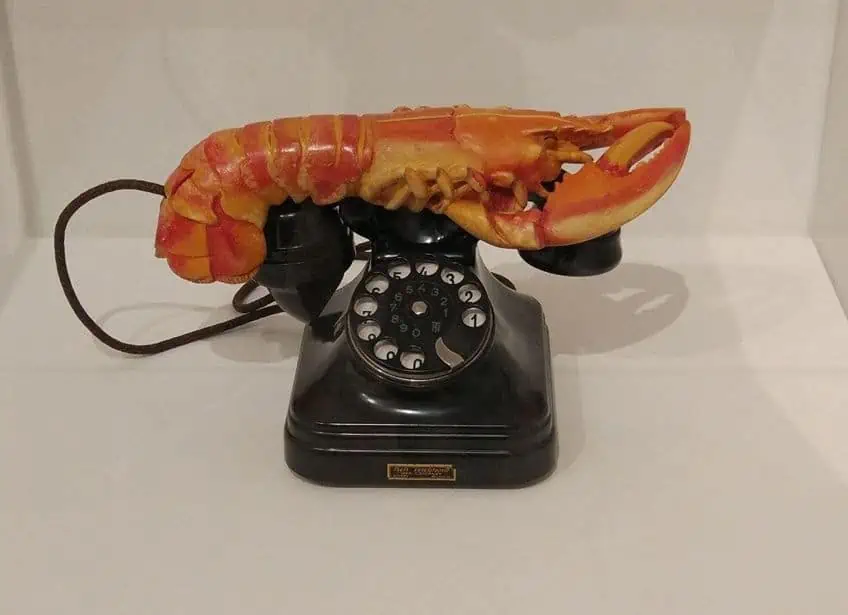
The Family (1918) by Egon Schiele
| Artist | Egon Leo Adolf Ludwig Schiele (1890 – 1918) |
| Date | 1918 |
| Medium | Oil on canvas |
| Dimensions (cm) | 152.5 x 162.5 |
| Where It Is Housed | The Belvedere Gallery, Vienna, Austria |
This strange painting is in reality, one of the saddest paintings in art history. Upon first glance, this strange family portrait may have you confused as to why the artist portrays his family in the nude. The Family is one of the last paintings created by Austrian Expressionist painter, Egon Schiele in the early 20th century. Despite the oddity of having a family portrait executed in the nude and the perceived awkwardness of the image, one might consider the reasoning behind the artwork. Schiele created this painting after the unfortunate death of his wife who was pregnant with his first child. The artist created this work as a last tribute to the family he wished to have.
An imagined image of his unborn child is featured in the foreground in front of his wife.
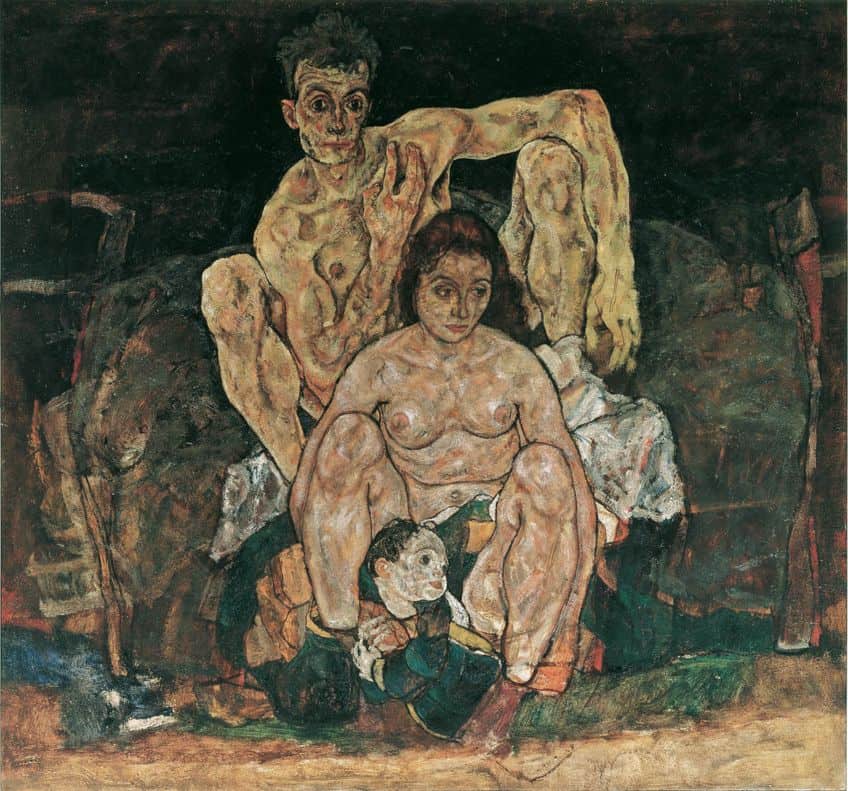
Monogram (1955 – 1959) by Robert Rauschenberg
| Artist | Milton Ernest Rauschenberg (Robert) (1925 – 2008) |
| Date | 1955 – 1959 |
| Medium | Oil, paper, fabric, printed reproductions, metal, wood, rubber shoe-heel, tennis ball on two conjoined canvases, oil on taxidermied Angora goat, brass plaque, rubber tire on a wood platform mounted on four casters |
| Dimensions (cm) | 106.7 x 160.7 x 163.8 |
| Where It Is Housed | Moderna Museet, Stockholm, Sweden |
Monogram is perhaps the weirdest artwork you will ever encounter from the 20th century. This unusual sculpture was created by American artist Robert Rauschenberg who used a found taxidermied goat as the attention-grabber of his artwork. Rauschenberg reportedly found the stuffed goat while on a New York dump and antique store haul. The artwork is said to be a symbol of lust and remains one of the most memorable readymade sculptures in Contemporary art history.
Angry Dog (1938 – 1943) by Edvard Munch
| Artist | Edvard Munch |
| Date | 1938 – 1943 |
| Medium | Watercolor on wove paper |
| Dimensions (cm) | 50 x 64.7 |
| Where It Is Housed | Munch Museum, Oslo, Norway |
This weird-looking dog painting was created by Norwegian painter Edvard Munch who was inspired by his neighbor’s pet dog, Rolle. Although a mundane subject, Munch chose to represent the hardships of his neighbor’s companion who was subject to neglect and eventually picked up an aggressive temperament. Munch’s other neighbor, Axel Gunnerud, adopted Rolle, and soon the dog was under proper care. The only issue was that Rolle only cared for Axel and had almost zero self-control when dealing with the occasional postman or local man. Munch was also subject to Rolle’s attacks, which perhaps informed the strange-looking character on the dog’s face in his painting.
The image of an angry dog is perhaps what made Munch view Rolle through an endearing lens.
The Physical Impossibility of Death in the Mind of Someone Living (1991) by Damien Hirst
| Artist | Damien Steven Hirst (1965 – Present) |
| Date | 1991 |
| Medium | Steel |
| Dimensions (cm) | 213 x 518 x 213 |
| Where It Is Housed | Metropolitan Museum of Art (2007 – 2010), New York, United States; Tate Modern (2012 – Present), London, United Kingdom |
Damien Hirst is famous for creating many bizarre installations and sculptures that make one question the mind of Hirst and his artistic choices. Hirst created this installation sculpture in 1991, which was composed of a formaldehyde-preserved tiger shark in a glass tank. This seemingly strange artwork would startle many who are unfamiliar with the general nature of Hirst’s works, which provoke the public through artworks that serve shock value and which make critical commentary on the state of the world through political, social, and Hirst’s philosophical discourses. The sculpture was funded by Charles Saatchi who supported the £50,000 project. Hirst’s shark tank was criticized by the New York Times as having missed the mark in general despite his attempt to “fry the mind” of the viewer. The shark was a symbol of both life and death and its suspension in the preserving fluid was what gave the artwork a “demonic” feel. What do you think of Hirst’s creation?
Vanitas: Flesh Dress for an Albino Anorectic (1987) by Jana Štěrbáková
| Artist | Jana Štěrbáková (1955 – Present) |
| Date | 1987 |
| Medium | Unavailable |
| Dimensions (cm) | Unavailable |
| Where It Is Housed | Collections: Walker Art Center, Minneapolis, United States and the Centre Pompidou, Paris, France |
This is perhaps one of the weirdest artworks of all time that was created out of slabs of beef, sewn together, and displayed on the dummy of a tailor. Vanitas: Flesh Dress for an Albino Anorectic is a meat dress created by Canadian artist Jana Štěrbáková in 1987 and was first displayed at the National Gallery of Canada. The strange artwork attracted a fair amount of controversy from those who did not understand the reasoning behind the meat dress as well as the placement of the work in an institution such as the National Gallery of Canada. Štěrbáková’s intention behind the meat dress was to emphasize the contrast between bodily decomposition through the flesh and human vanity, through the façade of the dress.
The artwork in its entirety is considered to be a vanitas artwork, which describes artwork related to highlighting the vanity of life and human mortality.
Body Worlds (Est. 1995) by Dr. Gunther von Hagens
| Artist | Dr. Gunther von Hagens (1945 – Present) |
| Date | Est. 1995 |
| Medium | Plastinated human bodies |
| Dimensions (cm) | Varied |
| Where It Is Housed | No set location; traveling exhibitions |
Body Worlds is the strangest exhibition held by German anatomist Dr. Gunther von Hagens. Hagens is most famous for his invention of human sculptures that were initially meant to serve as educational sculptures. The nature of his work, which made use of real human cadavers, was, of course, interrogated in the early 21st century and he has since remained one of the most controversial figures. Hagens invented a process called plastination whereby he injects a liquid plastic solution into human bodies, who were once volunteers. His weird works have garnered massive crowds of up to 26 million people, all reacting in a mixed bag of shock, fascination, and disdain for the work.
Untitled (2008) by Roger Hiorns
| Artist | Roger Hiorns (1975 – Present) |
| Date | 2008 |
| Medium | Atomized passenger aircraft engine |
| Dimensions (cm) | Variable |
| Where It Is Housed | Unavailable |
Roger Hiorns is a British Contemporary artist who is famous for his unusual works of art that border on genius and both the “weird”. Hiorns “dust piece” was a sculpture made purely out of an atomized aircraft engine, which can be likened to Marcel Duchamp’s presentation of the famous urinal Fountain (1917), which shocked the audience yet questioned the concept of what a sculpture could be. Hiorns’ dust sculpture further questions the boundaries of what one considers to be a sculpture and may be weird at first, but potentially genius at best.
These top 15 weirdest artworks in art history have all had their turn at generating sufficient shock value across the world for their unique approaches in realization. By reviewing these “weird” artworks from an objective standpoint, one might propose that perhaps the perception of what many deem as strange and too shocking at one point in history may be too extraordinary to understand at present. Some might argue that weird artworks are artworks that do not make sense, yet, in their senselessness, meaning can still be discovered. What do you think of strange art?
Take a look at our weird paintings webstory here!
Frequently Asked Questions
What Is the Weirdest Painting in Art History?
The title of the weirdest painting in art history is collectively shared between Hieronymus Bosch’s The Garden of Earthly Delights (c. 1490 – 1500) and Melun Diptych (c. 1452) by Jean Fouquet.
What Makes an Artwork Weird?
Artwork is considered to be weird or strange when its subject matter, composition, visual aesthetic, or combination of these factors challenges existing social perceptions of what art is supposed to portray and how artists generally present images or subjects. Artworks are also categorized as weird when the medium involved differs from widely-recognized mediums in art, and which seem to have an unlikely association with the art sphere.
Which Artists Are Associated With Creating Weird Art?
Artists associated with creating weird artworks include artists that have received considerably more negative criticism than most artists working within the traditional boundaries of art in their respective periods. These artists include modern and historical figures like Damien Hirst, Salvador Dalí, Francisco de Goya, Hieronymus Bosch, Jean Fouquet, and many other artists who created artworks with a considerably high shock-value effect.
Jordan Anthony is a Cape Town-based film photographer, curator, and arts writer. She holds a Bachelor of Art in Fine Arts from the University of the Witwatersrand, Johannesburg, where she explored themes like healing, identity, dreams, and intuitive creation in her Contemporary art practice. Jordan has collaborated with various local art institutions, including the KZNSA Gallery in Durban, the Turbine Art Fair, and the Wits Art Museum. Her photography focuses on abstract color manipulations, portraiture, candid shots, and urban landscapes. She’s intrigued by philosophy, memory, and esotericism, drawing inspiration from Surrealism, Fluxus, and ancient civilizations, as well as childhood influences and found objects. Jordan is working for artfilemagazine since 2022 and writes blog posts about art history and photography.
Learn more about Jordan Anthony and about us.
Cite this Article
Jordan, Anthony, “Weirdest Artworks – Bizarre Art That Messes With Your Mind.” artfilemagazine – Your Online Art Source. January 31, 2023. URL: https://artfilemagazine.com/weirdest-artworks/
Anthony, J. (2023, 31 January). Weirdest Artworks – Bizarre Art That Messes With Your Mind. artfilemagazine – Your Online Art Source. https://artfilemagazine.com/weirdest-artworks/
Anthony, Jordan. “Weirdest Artworks – Bizarre Art That Messes With Your Mind.” artfilemagazine – Your Online Art Source, January 31, 2023. https://artfilemagazine.com/weirdest-artworks/.



